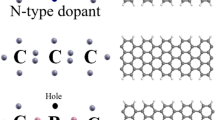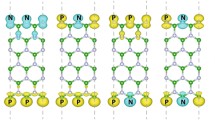Abstract
We study the effects of edge passivation by N atoms on the magnetic and electrical properties of zigzag borophene nanoribbons (ZBNRs) employing the density functional theory combined with the non-equilibrium Green’s function method. Significant enhancement on the edge magnetism is found in general, in contrast to the magnetism suppression in hydrogenated ZBNRs, and half-metallicity can be observed in some special cases. Different from the graphene nanoribbons, the properties of ZBNRs are sensitive to the ribbon width, since their electronic structures fluctuate greatly with the width. Magnetism and conductivity change sharply and the ground state jumps back and forth between the ferromagnetic and antiferromagnetic configurations as the ribbon width increases. Spin-dependent negative differential resistivity may be realized in N-passivated ZBNRs.







Similar content being viewed by others
References
Bezanilla AL, Littlewood PB (2016) Electronic properties of 8-Pmmn borophene. Phys Rev B 93:241405(R)
Brandbyge M, Mozos JL, Ordejon P, Taylor J, Scokbro K (2002) Density-functional method for nonequilibrium electron transport. Phys Rev B 65:165401
Datta S (2005) Quantum transport: atom to transistor. Cambridge University Press, New York
Dong YJ, Wang XF, Yang SW, Wu XM (2014) High performance current and spin diode of atomic carbon chain between transversely symmetric ribbon electrodes. Sci Rep 4:6157
Feng YP, Shen L, Yang M, Wang AZ, Zeng MG, Wu QY, Chintalapati S, Chang CR (2017a) Prospects of spintronics based on 2D materials. WIREs Comput Mol Sci 7:e1313
Feng BJ, Sugino O, Liu RY, Zhang J (2017b) Dirac fermions in borophene. Phys Rev Lett 118:096401
Fuente AG, Carrete J, Vega A, Gallego LJ (2017) How will freestanding borophene nanoribbons look like? An analysis of their possible structures, magnetism and transport properties. Phys Chem Chem Phys 19:1054–1061
Gao M, Li QZ, Yan XW, Wang J (2017) Prediction of phonon mediated superconductivity in borophene. Phys Rev B 95:024505
Geim AK (2009) Graphene: status and prospects. Science 324:1530–1534
Giannopoulos GI (2017) Mechanical behavior of planar borophenes: a molecular mechanics study. Comput Mater Sci 129:304–310
Gupta AS, Seal S, Sakthivel T (2015) Recent development in 2D materials beyond graphene. Prog Mater Sci 73:44–126
Jiang C, Wang XF, Zhai MX (2014) Spin negative differential resistance in edge doped zigzag graphene nanoribbons. Carbon 68:406–412
Jiang HR, Lu Z, Wu MC, Ciucci F, Zhao TS (2016) Borophene: a promising anode material offering high specific capacity and high rate capability for lithium-ion batteries. Nano Energy 23:97–104
Kan EJ, Li ZY, Yang JL, Hou JG (2008) Half-metallicity in edge-modified zigzag graphene nanoribbons. J Am Chem Soc 130:4224–4225
Li YF, Zhou Z, Shen PW, Chen ZF (2009) Spin gapless semiconductor-metal-half-metal properties in nitrogen-doped zigzag graphene nanoribbons. ACS Nano 3:1952–1958
Liu YX, Dong YJ, Tang ZY, Wang XF, Wang L, Hou TJ, Lin HP, Li YY (2016) Stable and metallic borophene nanoribbons from first-principles calculations. J Mater Chem C 4:6380
Liu G, Wang H, Gao Y, Zhou J, Wang H (2017) Anisotropic intrinsic lattice thermal conductivity of borophene from first-principles calculations. Phys Chem Chem Phys 19:2843–2849
Mannix AJ, Zhou XF, Kiraly B, Wood JD, Alducin D, Myers BD, Liu XL, Fisher BL, Santiago U, Guest JR, Yacaman MJ, Ponce A, Oganov AR, Hersam MC, Guisinger NP (2015) Synthesis of borophenes: anisotropic, two-dimensional boron polymorphs. Science 350:1513–1516
Meng FC, Chen XG, Sun SS, He J (2017) Electronic and magnetic properties of pristine and hydrogenated borophene nanoribbons. Phys E 112:91106
Peng B, Zhang H, Shao H, Xu YF, Zhang RJ, Zhu HY (2016) The electronic, optical, and thermodynamic properties of borophene from first-principles calculations. J Mater Chem C 4:3592–3598
Perdew JP, Burke K, Ernzerhof M (1997) Generalized gradient approximation made simple. Phys Rev Lett 78:1396
Rao DW, Zhang LY, Meng ZS, Zhang XR, Wang YH, Qiao GJ, Shen XQ, Xia H, Liu JH, Lu RF (2017) Ultrahigh energy storage and ultrafast ion diffusion in borophene-based anodes for rechargeable metal ion batteries. J Mater Chem A 5:2328–2338
Tan CL, Cao XH, Wu XJ, He QY, Yang J, Zhang X, Chen JZ, Zhao W, Han SK, Nam GH, Sindoro M, Zhang H (2017) Recent advances in ultrathin two-dimensional nanomaterials. Chem Rev 117:6225–6331
Taylor J, Guo H, Wang J (2001) Ab initio modeling of quantum transport properties of molecular electronic devices. Phys Rev B 63:245407
Vishkayi SI, Tagani MB (2018) Edge-dependent electronic and magnetic characteristics of freestanding β12-borophene nanoribbons. Nano Micro Lett 10:14
Wang V, Geng WT (2017) Lattice defects and the mechanical anisotropy of borophene. J Phys Chem C 121:10224–10232
Wang XF, Hu YB, Guo H (2012) Robustness of helical edge states in topological insulators. Phys Rev B 85:241402(R)
Wang H, Li Q, Gao Y, Miao F, Zhou XF, Wan XG (2016) Strain effects on borophene: ideal strength, negative Possion’s ratio and phonon instability. New J Phys 18:073016
Wu TT, Wang XF, Zhai MX, Liu H, Zhou LP, Jiang YJ (2012) Negative differential spin conductance in doped zigzag graphene nanoribbons. Appl Phys Lett 100:052112
Xiao RC, Shao DF, Lu WJ (2016) Enhanced superconductivity by strain and carrier-doping in borophene: a first principles prediction. Appl Phys Lett 109:122604
Xu MS, Liang T, Shi MM, Chen HZ (2013) Graphene-like two-dimensional materials. Chem Rev 113:3766–3798
Yung KC, Wu WM, Pierpoint MP, Kusmartsev FV (2013) Introduction to graphene electronics—a new era of digital transistors and devices. Contemp Phys 54:233–251
Zhai MX, Wang XF (2016) Atomistic switch of giant magnetoresistance and spin thermopower in graphene-like nanoribbons. Sci Rep 6:36762
Zhao YC, Zeng SM (2016) Phonon-mediated superconductivity in borophenes. App Phys Lett 108:242601
Zheng XH, Wang XL, Abtew TA, Zeng Z (2010) Building half-metallicity in graphene nanoribbons by direct control over edge states occupation. J Phys Chem C 114:4190–4193
Acknowledgements
This work was supported by the National Natural Science Foundation of China (Grant Nos. 61674110, 6167204, and 11274238).
Author information
Authors and Affiliations
Corresponding author
Ethics declarations
Conflict of interest
None of the authors of this manuscript have any competing interests.
Additional information
Publisher's Note
Springer Nature remains neutral with regard to jurisdictional claims in published maps and institutional affiliations.
Electronic supplementary material
Below is the link to the electronic supplementary material.
Rights and permissions
About this article
Cite this article
Sun, C., Wang, XF., Zhou, LP. et al. The magnetism enhancement and spin transport in zigzag borophene nanoribbons edge-passivated by N atoms. Appl Nanosci 10, 29–35 (2020). https://doi.org/10.1007/s13204-019-01092-4
Received:
Accepted:
Published:
Issue Date:
DOI: https://doi.org/10.1007/s13204-019-01092-4




